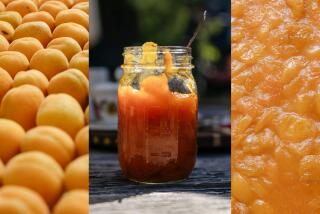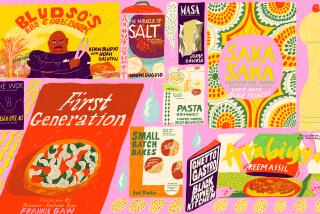The Secret Ingredient
My siblings and I grew up in Long Beach with a 40-foot persimmon tree in our back yard. We learned how to climb in its rangy branches and discovered that the green, golf ball-size fruit made great ammo. Later, in the fall, we carried nearly ripe persimmons to our teachers.
Persimmons, the soft, flame-orange globes of autumn, are far from America’s favorite fruit. Some people are put off by the puckery taste when the fruit is underripe; others find the slippery texture of the raw ripe fruit unappetizing. Most Americans have never tasted a persimmon. I love them.
To my mind, the best way to eat a perfectly ripe persimmon is slightly chilled. But like raw oysters, raw persimmons aren’t for everyone. Persimmon puree, on the other hand, used as an ingredient in baking, often converts those who are resistant to the pleasure of this West Coast fruit. It’s the secret ingredient in my fall baking. The puree’s subtle persimmon flavor blends well with spices, dried fruits and nuts. And it contributes a rich orangy-brown color as well as ensuring tender, moist results.
There are two main kinds of persimmons. Our tree was of the Hachiya variety, with big, acorn-shaped fruit, the kind most often sold at greengrocers and supermarkets. It’s the variety I’ve always used for baking. This eye-catcher is fully ripe when the skin is translucent and the red-orange flesh is soft, almost like a water balloon. Underripe, the fruit is unpalatable.
The Fuyu persimmon, a smaller, tomato-shaped fruit, is a non-astringent type that remains crisp and firm even when ripe. It is usually peeled and eaten raw, somewhat like an apple. Both varieties are native to Asia, where they have been cultivated for more than 1,000 years.
The hearty American persimmon, a third type and rarely seen in markets, grows wild in the Eastern United States. Its fruit is smaller than the fruit of Asian varieties.
Over the years, my love for persimmons has led me to collect many recipes. There’s our next-door-neighbor’s persimmon cookie recipe, thick with nuts and raisins, that became our contribution to school bake sales, family gatherings and packages to away-from-home siblings. Another cookie, this one a thin spicy bar with a sweet lemony glaze, is made by a friend of Japanese ancestry whose father sends her a box of carefully wrapped persimmons every year from his nursery near San Francisco Bay. Sometimes she shares her bounty with me.
But one of my favorite recipes shows how persimmons can be substituted for richer ingredients in baking. As a child, I remember Christmas dinner at my grandparents’ table, with me seated on a dictionary in the high-ceilinged room. As the lights were dimmed, my grandmother’s English friend, Mrs. Bromley, carried a flaming plum pudding into the hushed room. Like my young nieces and nephews now, I didn’t care as much about the taste as about the favors hidden inside. A ring indicated the next to be married; a shiny sixpence guaranteed wealth.
*
Years later, as concerns about excess fat and cholesterol grew, our suet-rich plum pudding, served with generous amounts of hard sauce, seemed less appropriate. A persimmon pudding, studded with golden raisins, dried apricots and dates--in place of the customary, rather insipid, candied fruit--was the answer. A lighter version tastes better after a big meal. And I can make this old-fashioned steamed pudding weeks before Christmas and then, taking advantage of modern technology, reheat it in the microwave.
Of all the places I’ve lived, Palo Alto has the best persimmon-growing climate. Our five years there were graced with a gangling, overloaded tree hanging halfway over the back fence. Our neighbor invited us to “take all you want before the birds get them.”
Every fall, pre- and post-football parties included ideas for using up the persimmons. I learned to whirl the mushy ones with a little lemon juice in a blender, then freeze the puree for future cakes, muffins, pies and puddings.
Seattle, where I live now, isn’t ideal persimmon-growing country; it’s too cold. But a few trees survive, often snuggled up to a south-facing wall. Now, in November, all the leaves have blown off one nearby tree, leaving its bare branches adorned with red-orange spheres set against the stormy sky.
In the warm climate where I grew up, the leathery leaves turn yellow, orange and scarlet as the fruit ripens. In our dining room we have a persimmon watercolor depicting ripe fruit nestled among multicolored leaves. Friends joke that the painter had probably never seen a persimmon tree and mistakenly painted both the fruit and the leaves together. When told that story, the artist--my mom, who still has the same persimmon tree in her back yard--just laughs.
STEAMED PERSIMMON PLUM PUDDING
A fluted, tube-shaped metal pudding mold with a clip-on lid is a traditional choice for steamed puddings, but a simple ceramic bowl tightly covered with foil makes a good substitute. Add foil-wrapped charms, if you like, just before serving. Note that if the mold you use is deeper than usual, it may take longer for the pudding to set.
PLUM PUDDING
2 large, very ripe persimmons
1 teaspoon lemon juice
2 tablespoons butter, softened
3/4 cup sugar
1 egg
1 cup flour
1 1/2 teaspoons baking soda
1/4 teaspoon salt
1/2 teaspoon ground cinnamon
1/4 teaspoon ground nutmeg
1/4 teaspoon ground ginger
2 teaspoons grated lemon zest
1/2 cup milk
1/3 cup golden raisins
1/3 cup dried apricots, cut in quarters
1/3 cup coarsely chopped dates
1/4 cup currants
Brandy
Peel persimmons and puree fruit in blender or food processor to get about 1 cup. Stir in lemon juice and set aside.
Beat butter and sugar in bowl until fluffy. Beat in egg.
Combine flour, baking soda, salt, cinnamon, nutmeg and ginger in separate bowl. Add lemon zest and toss to mix. Add little at time to butter-egg mixture alternately with milk, beating well after each addition. Stir in persimmon puree, raisins, apricots, dates and currants.
Spoon into generously greased 6-cup pudding mold and cover. Place mold on steamer rack in large pan above gently boiling water. Water should not touch mold. Cover and steam, adding more boiling water as needed, until internal temperature reaches 190 degrees on instant-read thermometer or until toothpick comes out clean, about 2 hours. Cool 10 minutes and unmold.
Pudding may be served immediately. Otherwise, cool completely, wrap in cheesecloth moistened with brandy, then in foil, and place in plastic bag. May be refrigerated up to 1 month or frozen to keep longer.
To reheat cold pudding, unwrap, replace in mold and steam again 1 hour or until thoroughly heated. To reheat in microwave oven, place unwrapped pudding on microwave-safe plate and microwave 5 minutes on medium power, then let stand 5 minutes. Repeat heating and standing until pudding is heated through.
Warm 1/3 cup brandy slightly in long-handled pan. Carefully ignite and pour over warm pudding. Slice and serve with Brandied Hard Sauce.
BRANDIED HARD SAUCE
1/2 cup butter
1 cup sifted powdered sugar
3 tablespoons brandy
Beat butter to soften. Gradually beat in powdered sugar and brandy. Cover and chill. Makes 1 generous cup.
Makes about 8 servings.
Each serving, with hard sauce, contains about:
424 calories; 238 mg sodium; 66 mg cholesterol; 16 grams fat; 62 grams carbohydrates; 4 grams protein; 0.70 gram fiber.
PERSIMMON CORNMEAL CAKE
1/4 cup sliced almonds
1 1/4 cups sifted cake flour
1 3/4 cups sifted powdered sugar
1/2 cup yellow cornmeal
3/4 teaspoon baking powder
1/2 teaspoon salt
1/2 cup persimmon puree
1/2 teaspoon lemon juice
2 eggs, lightly beaten
1/4 cup oil
1/2 teaspoon vanilla extract
Toast almonds at 325 degrees until golden, about 10 minutes, shaking occasionally to prevent scorching. Sprinkle almonds inside buttered 8x4-inch loaf pan. Set aside.
Combine flour, powdered sugar, cornmeal, baking powder and salt in bowl of mixer and mix well.
In small bowl, combine persimmon puree, lemon juice, eggs, oil and vanilla extract. Add to dry ingredients and beat at low speed 1 minute. Scrape down sides of bowl and beat 1 minute more. Pour batter into loaf pan. Bake at 325 degrees until toothpick inserted near center comes out clean, about 45 to 50 minutes. Cool in pan 5 minutes before inverting onto rack to cool.
Makes 10 to 10 servings.
Each serving contains about:
242 calories; 163 mg sodium; 42 mg cholesterol; 9 grams fat; 39 grams carbohydrates; 4 grams protein; 0.28 gram fiber.
(BEGIN TEXT OF INFOBOX / INFOGRAPHIC)
Kitchen Tip
Many persimmon recipes call for persimmon puree. To make it, pull off the leathery base from your persimmons and cut them in half vertically. Using a spoon, scoop the pulp from the skin. Discard the skin and any seeds. Whirl the pulp until smooth in a blender or food processor, or force it through a food mill.
More to Read
Eat your way across L.A.
Get our weekly Tasting Notes newsletter for reviews, news and more.
You may occasionally receive promotional content from the Los Angeles Times.










